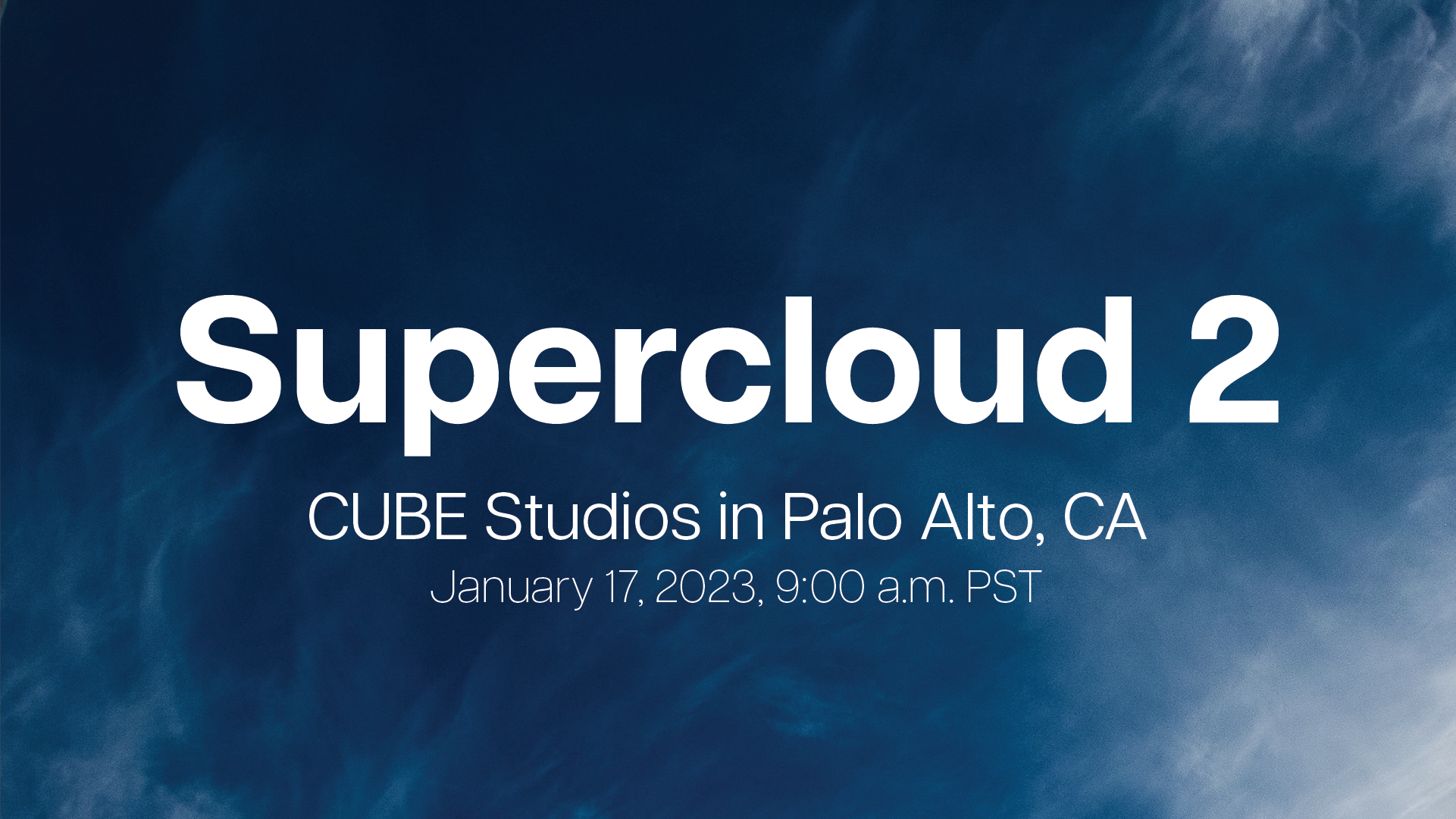 CLOUD
CLOUD
 CLOUD
CLOUD
 CLOUD
CLOUD
Enterprise tech practitioners, like most of us, want to make their lives easier so they can focus on delivering more value to their business. To do so, they want to tap best-of-breed services in the public cloud, but at the same time connect their on-premises intellectual property to emerging applications that drive top-line revenue and bottom-line profits.
But creating a consistent experience across clouds and on-prem estates has been an elusive capability for most organizations, forcing tradeoffs and injecting friction into the system. The need to create seamless experiences is clear and the technology industry is starting to respond with platforms, architectures and visions of what we’ve called supercloud.
In this Breaking Analysis, we give you a preview of Supercloud2, share key findings leading up to the event and highlight some of the areas we’ll be probing for in the live program.
Supercloud2 takes place at 9 a.m. PST Tuesday, Jan. 17. There will be 33 guests, 21 sessions combining live discussions, and fireside chats from theCUBE’s Palo Alto studio with prerecorded conversations on the future of cloud and data. You can register for free at supercloud.world.
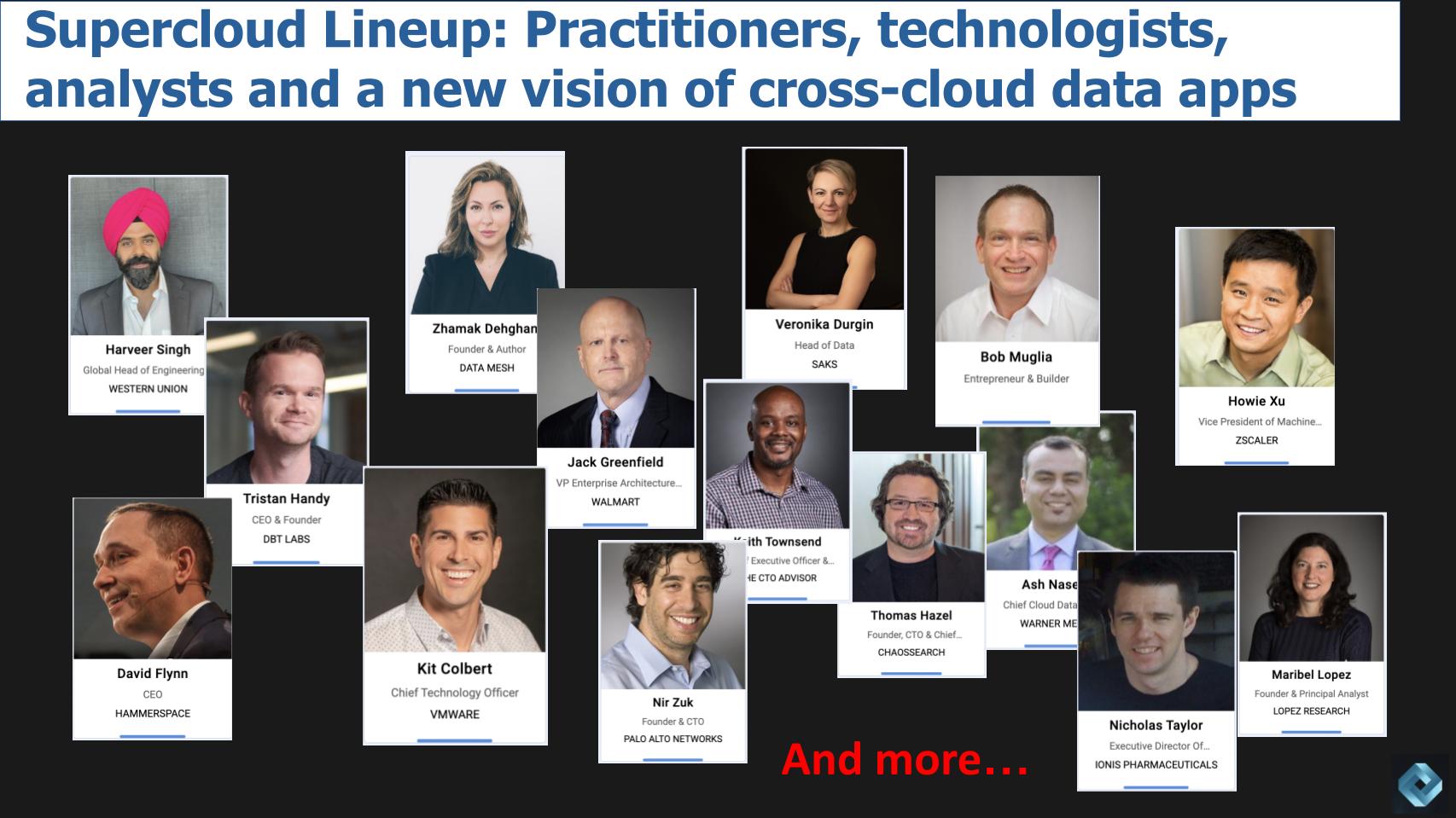
Whereas Supercloud22 was all about refining the definition of supercloud, testing its technical feasibility and understanding various deployment models, Supercloud2 features practitioners, technologists and analysts discussing what customers need with real-world examples of supercloud. We’ll also expose thinking around a new breed of cross-cloud apps – data apps, if you will – that change the way machines and humans interact with each other.
The example we’d use is that if you think about applications today, for example a customer relationship management system, sales reps are entering data into opportunities and choosing products and importing contacts and the like. And sure, the machine can take all that data and spit out a forecast by rep, by region, by product and so on. But today’s applications are largely about filling in forms and codifying processes.
In the future, the supercloud community sees a new breed of applications emerging where data resides on different clouds in different data stores and the machine uses AI to inspect the e-commerce system, the inventory data, supply chain information, sales forecasts, and so forth, then puts together a plan without any human intervention whatsoever. Think about a system that orchestrates people, places and things – like Uber for business.
At Supercloud2 you’ll hear about this data vision along with some of today’s challenges facing practitioners. Zhamak Dehghani, the founder of data mesh, is headlining. VMware Inc.’s Kit Colbert, who laid out an initial architecture for supercloud last August will present his most current thinking on the topic. Veronika Durgin of Saks Fifth Avenue will be featured and talk about data sharing across clouds.
One of the main highlights of Supercloud2 is a dive into Walmart Inc.’s supercloud. Other featured practitioners include Western Union, Ionis Pharmaceuticals, Warner Media, along with deep technology dives with folks such as Bob Muglia, David Flynn, Tristan Handy of dbt Labs Inc., Palo Alto Network Inc. founder Nir Zuk, Howie Xu of Zscaler Inc. and Thomas Hazel of ChaosSearch Inc., who will talk about a new type of database for supercloud. And there will be several analysts, including Keith Townsend, Maribel Lopez, Sarbjeet Johal, George Gilbert, Sanjeev Mohan… and so many more guests we don’t have time to list them all. They’re all up on supercloud.world with a full agenda.
Let’s take a look at some of the things we’re exploring in more detail starting with the Walmart Cloud Native Platform, WCNP. We definitely see this as a supercloud and we dig into it with Jack Greenfield, the head of architecture at Walmart.
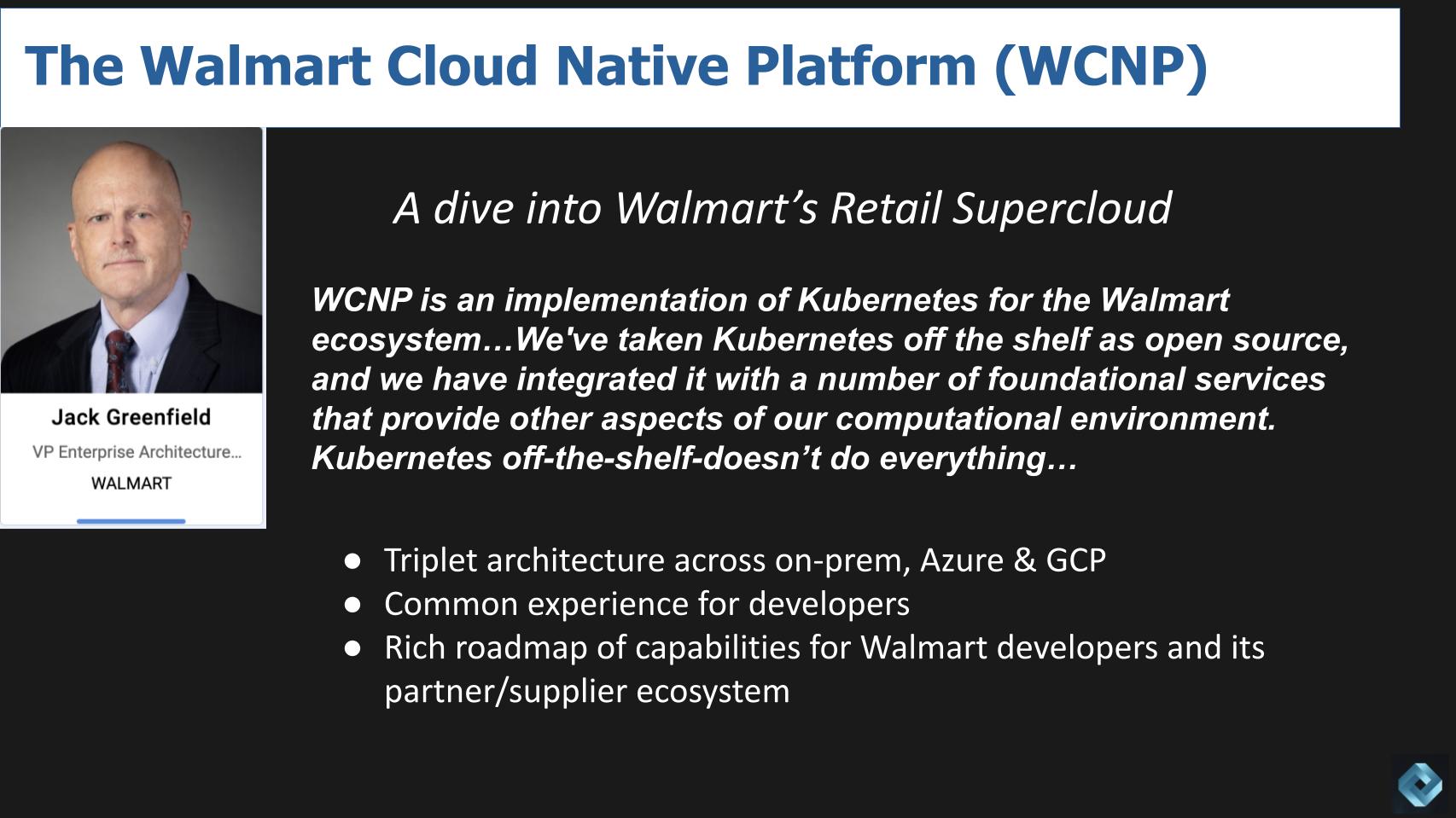
Here’s a quote from Jack:
WCNP is an implementation of Kubernetes for the Walmart ecosystem. We’ve taken Kubernetes off-the-shelf as open source, and we have integrated it with a number of foundational services that provide other aspects of our computational environment. Kubernetes off-the-shelf doesn’t do everything.
Walmart chose a do-it-yourself approach to build a supercloud for a variety of reasons Jack will explain, along with Walmart’s so-called triplet architecture connecting on-prem, Microsoft Azure and Google Cloud Platform. While Walmart didn’t mention this explicitly, we’d note they don’t to our knowledge use Amazon for obvious competitive reasons. Walmart’s platform creates a common experience for devs across clouds. A heavy user of open-source software, including OpenStack, Walmart has built a cloud-native platform that creates a common experience across estates.
Jack Greenfield will also talk about how Walmart is evolving its supercloud in the future. You don’t want to miss this.
Next let’s take a look at how Veronika Durgin of Saks thinks about data sharing across clouds. Data sharing is an alluring use case for supercloud if it can be done safely. Today there are many limits with sharing data, not the least of which is security and governance. Extend sharing outside of an organization and the problem compounds.

Here’s how Veronika Durgin sees it:
How do we talk to each other? And more importantly, how do we data share? If I want to get data from a company that’s using, say, Google, how do we share it in a smooth way where it doesn’t have to be this crazy FTP file moving? That’s where I think supercloud comes to mind, is like practical applications. How do we create that mesh, that network that we can easily share data with each other?
Listen to Veronika Durgin explain her views of data sharing across clouds.
Data mesh is a possible architectural approach that will enable more facile data sharing and the monetization of data products. You’ll hear Zhamak Dehghani live in-studio talking about what standards are missing to make this vision a reality across the supercloud.
One of the other things we’re really excited about is digging deeper into the right approach for supercloud adoption. Right now we’ll share a little debate going in the community.
Bob Muglia, former CEO of Snowflake Inc. and former Microsoft Corp. exec, was kind enough to spend some time looking at the community’s supercloud definition. He conveyed to us that it needed to be simplified. So in near-real time, he came up with the following definition we’re showing below.
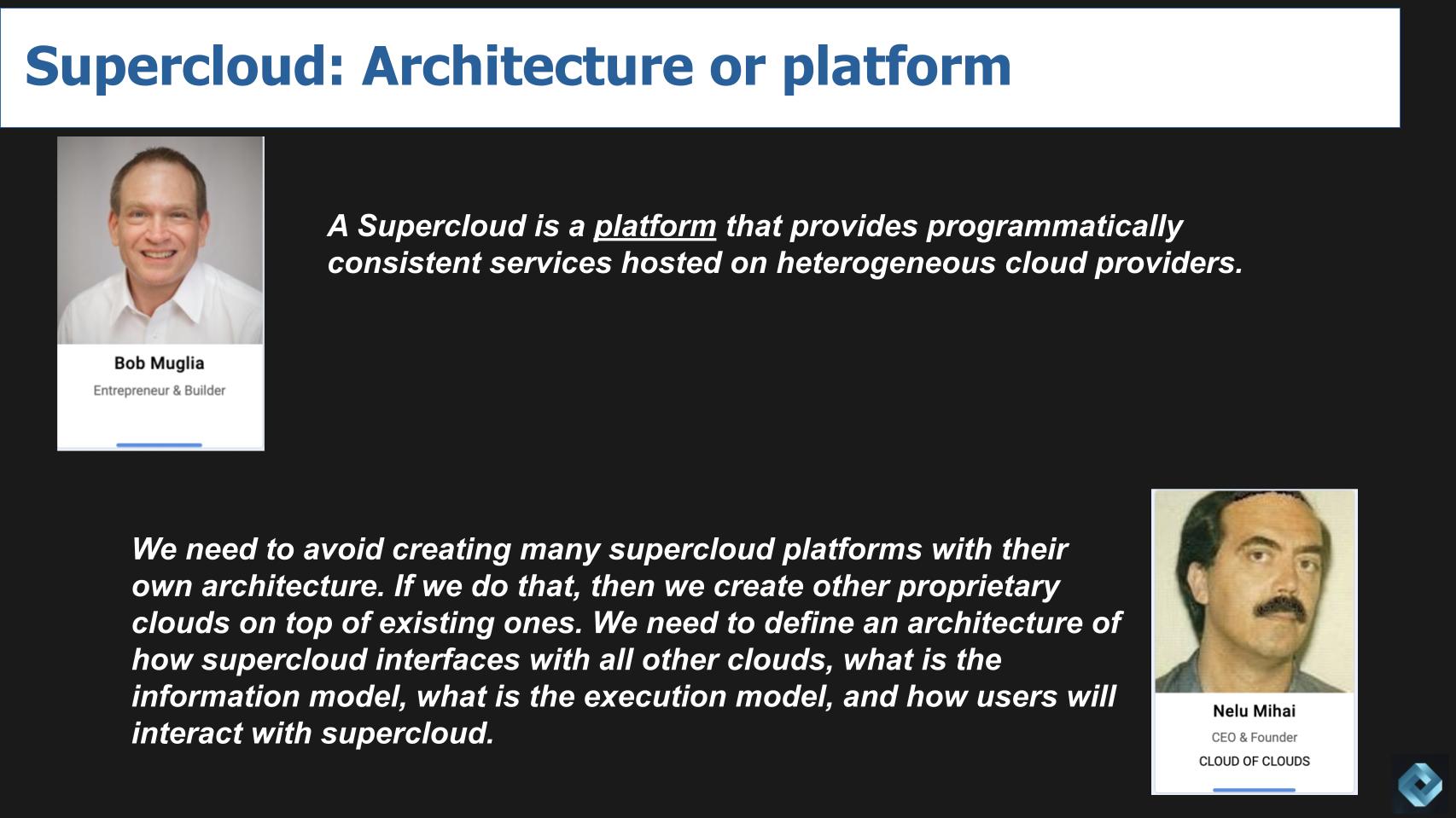
A supercloud is a platform that provides programmatically consistent services hosted on heterogeneous cloud providers.
Not only did Bob simplify the initial definition, he stressed that supercloud is a platform – versus an architecture. That implies that the platform provider (such as Snowflake, VMware, Databricks Inc., Cohesity Inc. and others) is responsible for determining the architecture.
Interestingly, in the shared Google doc that the working group uses to collaborate on the definition, Dr. Nelu Mihai, who is actually building a supercloud, responded as follows to Bob’s assertion:
We need to avoid creating many supercloud platforms with their own architecture. If we do that, then we create other proprietary clouds on top of existing ones. We need to define an architecture of how supercloud interfaces with all other clouds, what is the information model, what is the execution model, and how users will interact with supercloud.
Why does this seemingly nuanced point matter? Well, history suggests that de facto standards will emerge more quickly to solve real world problems and catch on more quickly than consensus-based architectures. But in the long run, the latter may serve customers better.
So we’ll be exploring this topic in more detail at Supercloud2. We’d love to hear what you think.
One of the technical gurus we’ll have in-studio at Supercloud2 is David Flynn. He was an early catalyst to the enterprise flash adoption craze with Fusion-io Inc. Today he and his team are working on a system to enable read/write data access to any user, any application, in any data center, on any cloud, anywhere. So think supercloud enabler.
Here’s an excerpt from a conversation David Flynn had with us after the first Supercloud event:
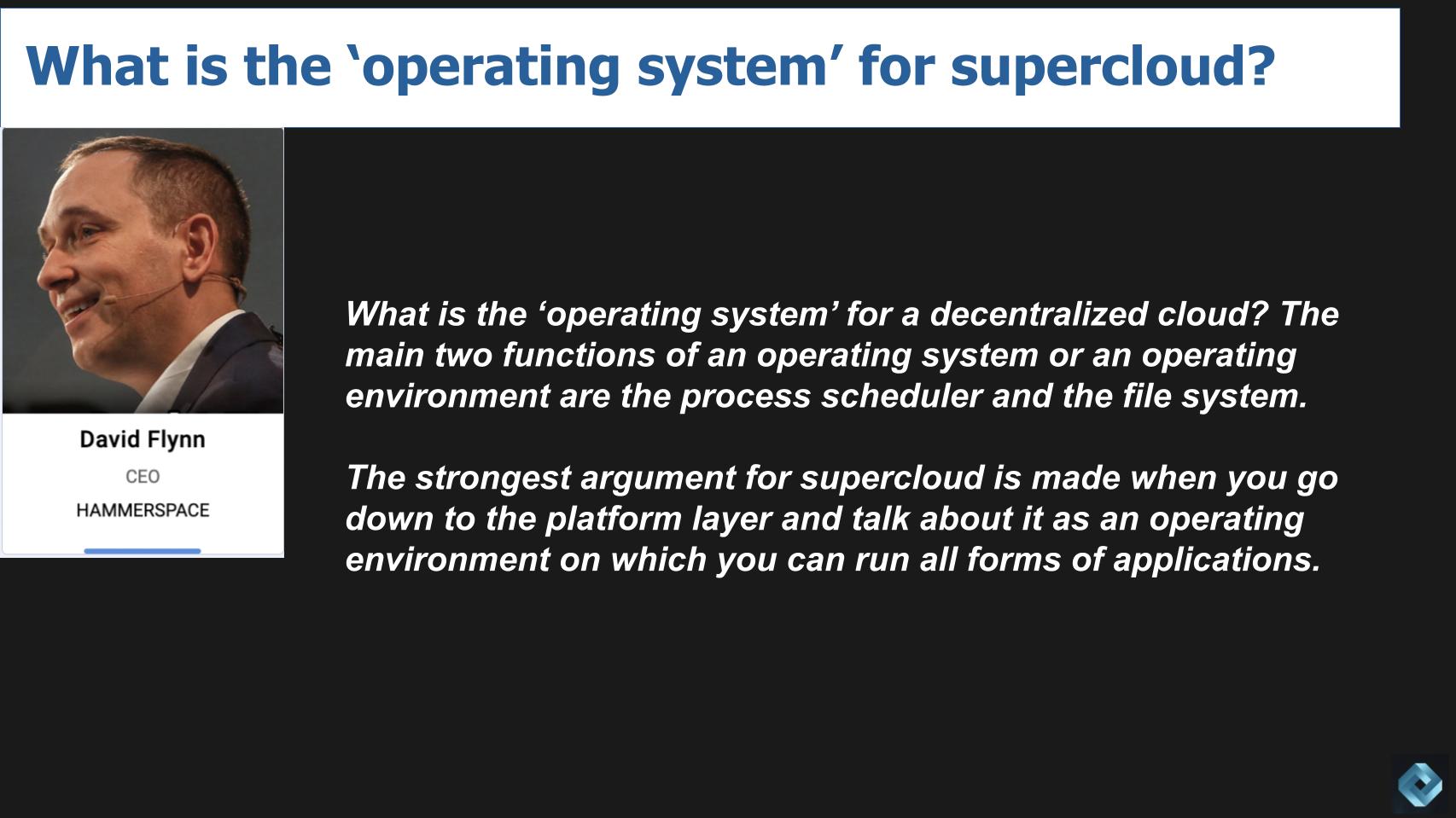
What is the “operating system” for a decentralized cloud? The main two functions of an operating system or an operating environment are the process scheduler and the file system.
The strongest argument for supercloud is made when you go down to the platform layer and talk about it as an operating environment on which you can run all forms of applications.
There are a couple of implications here that we’ll explore with David in-studio. First, we’re inferring he’s in the platform camp where the platform owner is responsible for the architecture… but we’ll have to clarify. And second, he’s basically saying the further you move up the stack, the weaker the supercloud argument becomes because it just becomes software as a service. This argument has merit based on our conversations at Supercloud22 with Intuit Chief Technology Officer Marianna Tessel. Charles Fitzgerald also makes a similar argument.
This is something we’ll investigate further to better understand his thinking on this, but also whether the existing notion of SaaS will change and a new breed of supercloud apps will emerge.
This brings us to a really interesting fellow that we spoke with ahead of Supercloud2. Tristan Handy is the founder and CEO of dbt Labs and a highly opinionated technical mind. Here’s what he said:
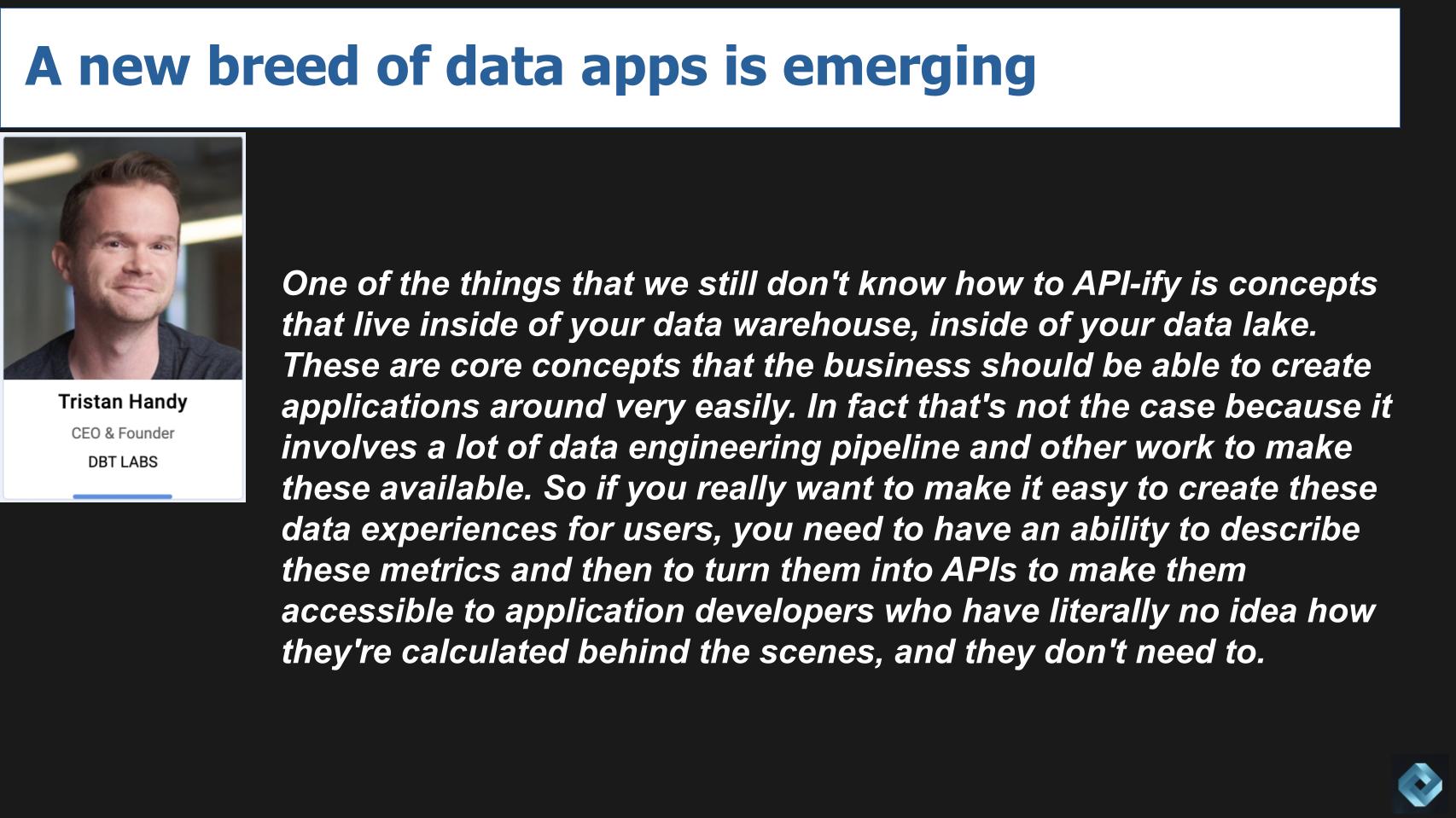
One of the things that we still don’t know how to API-ify is concepts that live inside of your data warehouse, inside of your data lake. These are core concepts that the business should be able to create applications around very easily. In fact, that’s not the case because it involves a lot of data engineering pipeline and other work to make these available. So if you really want to make it easy to create these data experiences for users, you need to have an ability to describe these metrics and then to turn them into APIs to make them accessible to application developers who have literally no idea how they’re calculated behind the scenes, and they don’t need to.
There are a lot of implications to this statement that we’ll highlight at Supercloud2. Zhamak Dehghani’s data mesh comes into play with her critique of hyperspecialized data pipeline experts with little or no domain knowledge. The need for simplified self-service infrastructure which Kit Colbert will likely touch upon. Veronika Durgin will share her ideal state for data sharing… along with Harveer Singh of Western Union dealing with 200 locations around the world and managing myriad data privacy and data sovereignty issues. Nick Taylor of Ionis Pharma as well speaks to this issue.
Further, Thomas Hazel and Bob Muglia posit that, to make data apps a reality, you have to rethink everything. You can’t just let in-memory databases and caching architectures take care of it in a brute-force manner. Rather, you have to think differently, even down to how data is laid out on disk (meaning flash) and think about rewriting applications for the supercloud as we enter the machine learning and artificial intelligence era.
All of this and more at Supercloud2.
A session like Supercloud2 wouldn’t be complete without some survey data. We pinged our friends from Enterprise Technology Research – Erik Bradley and Daren Brabham – to see if they had any data on Supercloud, and we’ll be analyzing a number of the prospective players with them. Many of you will be familiar with this graphic below:

Above we show some of the players involved in delivering or enabling supercloud-like capabilities. On the Y axis is Net Score or spending momentum and on the horizontal axis is market presence or pervasiveness in the data. And the table insert shows how the dots are plotted.
Not to steal ETR’s thunder, but the first point is you can’t have supercloud without the hyperscale cloud platforms shown on this graphic in the upper right.
But the most exciting aspect of supercloud is the opportunity for ecosystem partners and customers such as Walmart to build value on top of hyperscale clouds. Snowflake continues to show strong spending velocity as does Databricks, Hashicorp and Rubrik Inc..
Note VMware Tanzu’s momentum on the vertical axis. We all put Tanzu under the magnifying glass after the Broadcom Inc. announcement but it’s showing momentum.
Due to a scheduling conflict we weren’t able to get Red Hat on the program, but they’re clearly a player. We’ve put Cohesity and Veeam Software Corp. on the chart because backup is a likely use case across clouds and on-premises.
One other callout we drill down on at Supercloud2 is Cloudflare Inc., which actually uses the term supercloud albeit in a different way. It looks at supercloud really as serverless on steroids.
And so the data brains at ETR will have more to say on this topic at Supercloud2, along with many others.

A main goal of Supercloud2 was to hear from practitioners how they’re thinking about the future of cloud, multicloud and data. And in the case of Walmart, why they built a so-called supercloud and what problems it solves. As well, we want to explore the intersection of data and cloud because we believe if you follow the data, it will lead you to the future.
Data sharing will be a big theme at Supercloud2 and you’ll hear about use cases, challenges and key issues practitioners face in their data sharing journey.
We have some of the finest technologists in the world joining us at Supercloud2 and you’ll hear from them how they’re thinking about solving today’s problems and what the future holds, with a strong look at the future of data and cloud.
Is supercloud merely the next abstraction layer that will create more stovepipes, or can it truly be a fundamental ingredient of digital business? And can it support the development of new data products, monetization and new revenue streams for ecosystem partners and traditional customers?
We’ll answer these and your questions at Supercloud2, so please register for free at Supercloud.world.
We want to give a shout-out to our Supercloud2 supporters. VMware has been a great partner as our anchor supporter. ChaosSearch, Prosimo and Alkira as well contributed to the effort. And thanks to all the great guests who support our mission of creating free and open content for the technology community.
Many thanks to Alex Myerson and Ken Shifman on production, podcasts and media workflows for Breaking Analysis. Special thanks to Kristen Martin and Cheryl Knight who help us keep our community informed and get the word out, and to Rob Hof, our editor in chief at SiliconANGLE.
Remember we publish each week on Wikibon and SiliconANGLE. These episodes are all available as podcasts wherever you listen.
Email david.vellante@siliconangle.com, DM @dvellante on Twitter and comment on our LinkedIn posts.
Also, check out this ETR Tutorial we created, which explains the spending methodology in more detail. Note: ETR is a separate company from Wikibon and SiliconANGLE. If you would like to cite or republish any of the company’s data, or inquire about its services, please contact ETR at legal@etr.ai.
Here’s the full video analysis:
All statements made regarding companies or securities are strictly beliefs, points of view and opinions held by SiliconANGLE Media, Enterprise Technology Research, other guests on theCUBE and guest writers. Such statements are not recommendations by these individuals to buy, sell or hold any security. The content presented does not constitute investment advice and should not be used as the basis for any investment decision. You and only you are responsible for your investment decisions.
Disclosure: Many of the companies cited in Breaking Analysis are sponsors of theCUBE and/or clients of Wikibon. None of these firms or other companies have any editorial control over or advanced viewing of what’s published in Breaking Analysis.
Support our mission to keep content open and free by engaging with theCUBE community. Join theCUBE’s Alumni Trust Network, where technology leaders connect, share intelligence and create opportunities.
Founded by tech visionaries John Furrier and Dave Vellante, SiliconANGLE Media has built a dynamic ecosystem of industry-leading digital media brands that reach 15+ million elite tech professionals. Our new proprietary theCUBE AI Video Cloud is breaking ground in audience interaction, leveraging theCUBEai.com neural network to help technology companies make data-driven decisions and stay at the forefront of industry conversations.